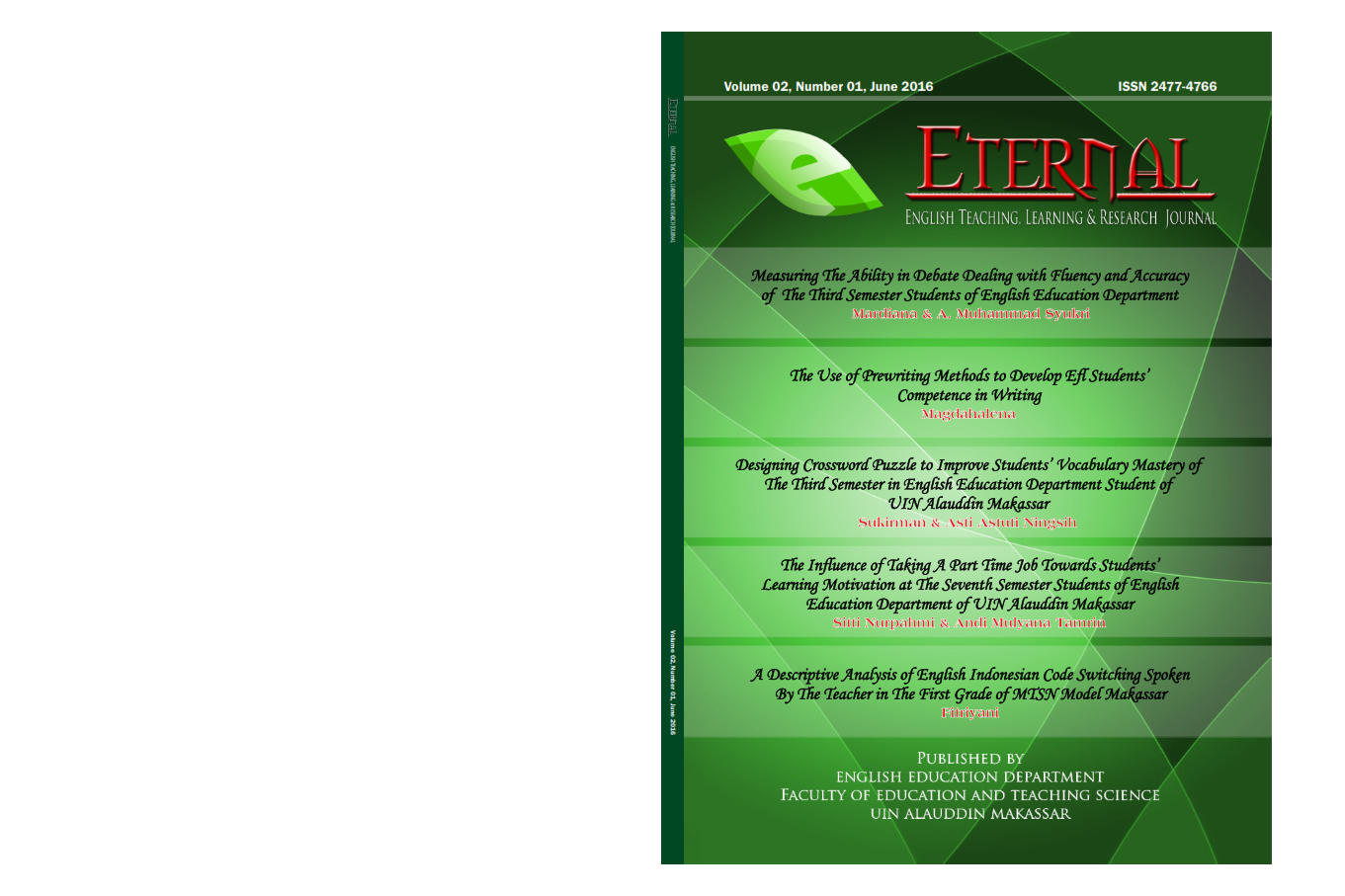THE EFFECTIVENESS OF USING CROSSING FORMULAS OF TENSES TABLE IN LEARNING ENGLISH 16 TENSES AT XII GRADE STUDENTS OF MA MADANI ALAUDDIN PAOPAO IN ACADEMIC YEAR OF 2015/2016
Abstract
The main objectives of this research were (1) To know whether the Crossing Formulas of Tenses Table is effective in Learning English 16 Tenses or not, (2) To find out how effective the Crossing Formulas of Tenses Table is in learning English 16 tenses. This research was conducted at MA Madani Alauddin Paopao in academic year of 2015/2016. The research design was Quasi Experimental Design with Pre-test and Post-test Design. The instrument used to collect the data was pre-test and post-test. The population of this research was XII Grade Students of MA Madani Alauddin Paopao which consists of class XII A and XII B. Class XII A had 26 students and class XII B had 24 students, therefore, the population of the research was 50 students. The technique used in sample taking was Cluster Random Sampling. Therefore, the sample of this research was 20 students in class XII A as experimental class, and 20 students in class XII B as controlled class. The result of pre-test showed that XII grade students’ ability about tenses was bad before the treatments were given. After giving treatment, the students’ mean score of post-test were increased significantly. To find out whether there was significance different between experimental class and controlled class, the researcher applied t- test. The result of t- test showed that the t-test value was higher than the t- table value at the level of significance was 0.05 with degree of freedom (df) (N1 + N2)-2 = (20 + 20)-2 = 38. It indicated that H1 was accepted and H0 was rejected. Based on the result of this research, it can be concluded that The Crossing Formulas of Tenses Table is effective in Learning English 16 Tenses at XII grade students of MA Madani Alauddin Paopao and there is significant difference between the students’ ability about English 16 tenses before and after using The Crossing Formula of Tenses Table.
Downloads
References
Ana, I Ketut Trika Adi, and Ni Made Ratminingsih. (2012). “Teaching English Tenses to EFL Learners: Deductive or Inductive?”. Retrieved from: http://infonomics-society.org/IJCDSE/Teaching%20English%20Tenses%20to%20EFL%20Learners%20Deductive%20or%20Inductive.pdf. on May 2015. Vol, 2, 998-1004Pdf.
Arikunto, S. (2010). Prosedur Penelitian. Jakarta: Rineka Cipta.
Azar, Betty Scrampfer, and Stacy A. Hagen. (2006). Basic English Grammar Third Edition with AnswerKey. Washington: Pearson Education.
Azar, Betty Scrampfer. (1999). Understanding and Using English Grammar Third Edition. Washington: Pearson Education.
Brown, H. Douglass, (1994). Principle of Language Learning & Teaching Third Edition. Prentice Hall. INC.
Dkhissi, Yahya. (2015). “An Integratve Model of Grammar Teaching:From Aademic to communicative needs”. Retrieved from: http://www.sciencepublishinggroup.com/j/ijll. on May 2015. 145-153Pdf.
Gay, L. R. Geoffrey E. Mills. Peter Airasian. (2006). Educational Research: Competencies for Analysis and Applications. 8th. ed. Ohio: Pearson.
Gerot, Linda, and Peter Wignell. (1995). Making Sense of Functional Grammar. Australia: Antipodean Educational Enterprise (AEE).
Greebaum, Sidney. Nelson Gerald. (2002). An Introduction to English Grammar: second edition. London: Pearson Education Limited.
Hewings, Martin. (2000). Advanced Grammar in Use with Answer. England: Cambridge University Press.
Hornby, A.S. (1995). Oxford Advanced Learners Dictionary of current Enslish. Oxford: Oxford University Press.
Inayah, Siti. (2010). Using Flashcard To Improve Students’ Understanding on Present Continuous Tense. Thesis FTK IAIN Walisongo Semarang.
Larsen-Freeman, Diane. (2000). Technique and Principal in Language Teaching. New York: Oxfodr University Psress.
Latief, Mohammad Adnan. (2014). Research Methods on Language Learning an Introduction. Malang: UM Press.
Lech, Geoffy, Margaret and Robert Hoogrenroad. (2000).English Grammar for to Day a New Introduction. Mac Millan: The Englsih Association.
Mohammed, Abdu Al-Mekhafi, and Ramani Perur Nagaratnam. (2011). “Difficulties in Teaching And Learning Grammar In An EFL Context”. Vol.4, No.2.
Muhib, Abdul. (2007). English Grammar Exercise. Pare.
Ovalina. (2010). Improving Students’ Ability in Using The Simple Past Tense Through Contextual Teaching Learning. Thesis FTK UIN Syarif Hidayatullah Jakarta.
Oxford. (2000). Oxford Learner Pocket Dictionary New Edition. New York: Oxford University Press.
Richards, Jack C and Theodore S. Rodgers. (1999). Approaches and Methods in Language Teaching. USA: Cambridge University Press.
Suciarti, Windhy. Teaching Tenses By Using Grammar Translation Method at Fisrt Grade Students of SMP BHAKTI MULYA BANDUNG BARAT. Thesis STKIP Siliwangi Bandung.
Sugiono. (2011). Metode Penelitian Pendidikan. Bandung.
Swan, Michael, and Catherine Walter. (2002). How English Work A grammar Practice Book with Answer. China: Oxford University Press.
Thronbury, Scout. (1999). How to Teach Grammar. England: Pearson Education Limited.
Wilkinson, George, and Deny Haryanto. (2009). Complete English Grammar. Jakarta: Pustaka Indonesia.
William, James D. (2005). The Teacher’s Grammar Book: second edition. New Jersey: Lawrence Erlbaum Associates, Publishers.
Woodward, Suzanne W. (1997). Fun With Grammar. United Stated of America: Prentice Hall Regents.
Copyright notice:
- Authors retain copyright and grant the journal right of first publication with the work simultaneously licensed under a Creative Commons Attribution License that allows others to share the work with an acknowledgement of the work's authorship and initial publication in this journal.
- Authors are able to enter into separate, additional contractual arrangements for the non-exclusive distribution of the journal's published version of the work (e.g., post it to an institutional repository or publish it in a book), with an acknowledgement of its initial publication in this journal.
- Authors are permitted and encouraged to post their work online (e.g., in institutional repositories or on their website) prior to and during the submission process, as it can lead to productive exchanges, as well as earlier and greater citation of published work (See The Effect of Open Access)

